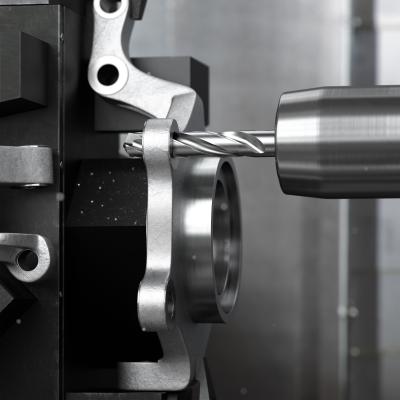
Two new drills optimized for drilling aluminum automotive parts have been developed by Sandvik Coromant. Suitable for the machining of components in medium-to-large volumes, CoroDrill 400 and CoroDrill 430 deliver high throughput and low costs, as well as extended tool life and enhanced process security. The drills are supported by CoroTap 100, 200, 300 and 400, which are also optimized for tapping operations in ISO N materials and help provide a complete holemaking offer from a single source for those tasked with producing aluminum automotive components.
“Automotive manufacturers are increasingly adopting aluminum parts to help reduce vehicle weight and improve fuel efficiency,” says Aaron Howcroft, global product manager at Sandvik Coromant. “These latest drills with grades optimized for ISO N materials offer a host of benefits, including high reliability, enhanced precision, low cost-per-hole, longer and more consistent tool life, high repeatability and improved process security.”
While both CoroDrill 400 and CoroDrill 430 are available in the Sandvik Coromant N1BU solid-carbide grade, the former can also be selected in the new N1DU veined polycrystalline diamond (PCD) grade. N1DU provides PCD across the entire cutting edge, thus offering longer tool life. Due to PCD’s low coefficient of friction and high conductivity of heat, the tool’s cutting edges are less susceptible to built-up edge (BUE). As a general guide, Sandvik Coromant recommends the use of the solid-carbide grade when the hole count is low and handling risk is high. Conversely, the PCD grade is preferable when the hole count is high and higher productivity is required.
CoroDrill 400 is recommended for drilling into solid material, as it features more flute volume for better chip evacuation. When drilling into cored material or pre-cast holes, CoroDrill 430 will perform better, as it features three flutes for increased stability and holding true position regardless of misaligned cored holes.
Optimized features of CoroDrill 400 and CoroDrill 430 include polished flutes and precision coolant holes, with support provided for MQL (minimum quantity lubrication). The drills are conveniently available as standard products in 5, 6.8, 7, 8.5, 10.2 and 12.5 mm diameters, which correspond to M6, M8, M10, M12 and M14 thread sizes. Tailor Made options can also be specified for other applications.
The new tools belong to the Sandvik Coromant Solid Round Tools Optimized range, a line of refined round tools for specific needs that provide extreme efficiency, reliability and durability. Customers should select the Optimized range when a dedicated tool is required for a specific material or application.
Supporting the drills are CoroTap 100, 200, 300 and 400, a series of taps that is also designed specifically for use in ISO N materials. CoroTap 100 is straight-flute tap for through and blind holes that features interrupted threads for less torque and increased coolant penetration.
CoroTap 200 is a spiral-point tap and CoroTap 300 a spiral-flute tap for through and blind holes respectively. These taps are available as high helix (35°) uncoated variants for low Si content aluminum, or low helix (15°) coated or uncoated types for abrasive, high Si content materials. CoroTap 400 is a forming tap for through and blind holes that features optimized lobe and thread lengths to reduce torque in aluminum workpieces.
Contact Details
Related Glossary Terms
- abrasive
abrasive
Substance used for grinding, honing, lapping, superfinishing and polishing. Examples include garnet, emery, corundum, silicon carbide, cubic boron nitride and diamond in various grit sizes.
- built-up edge ( BUE)
built-up edge ( BUE)
1. Permanently damaging a metal by heating to cause either incipient melting or intergranular oxidation. 2. In grinding, getting the workpiece hot enough to cause discoloration or to change the microstructure by tempering or hardening.
- coolant
coolant
Fluid that reduces temperature buildup at the tool/workpiece interface during machining. Normally takes the form of a liquid such as soluble or chemical mixtures (semisynthetic, synthetic) but can be pressurized air or other gas. Because of water’s ability to absorb great quantities of heat, it is widely used as a coolant and vehicle for various cutting compounds, with the water-to-compound ratio varying with the machining task. See cutting fluid; semisynthetic cutting fluid; soluble-oil cutting fluid; synthetic cutting fluid.
- flutes
flutes
Grooves and spaces in the body of a tool that permit chip removal from, and cutting-fluid application to, the point of cut.
- polycrystalline diamond ( PCD)
polycrystalline diamond ( PCD)
Cutting tool material consisting of natural or synthetic diamond crystals bonded together under high pressure at elevated temperatures. PCD is available as a tip brazed to a carbide insert carrier. Used for machining nonferrous alloys and nonmetallic materials at high cutting speeds.
- polycrystalline diamond ( PCD)2
polycrystalline diamond ( PCD)
Cutting tool material consisting of natural or synthetic diamond crystals bonded together under high pressure at elevated temperatures. PCD is available as a tip brazed to a carbide insert carrier. Used for machining nonferrous alloys and nonmetallic materials at high cutting speeds.
- tap
tap
Cylindrical tool that cuts internal threads and has flutes to remove chips and carry tapping fluid to the point of cut. Normally used on a drill press or tapping machine but also may be operated manually. See tapping.
- tapping
tapping
Machining operation in which a tap, with teeth on its periphery, cuts internal threads in a predrilled hole having a smaller diameter than the tap diameter. Threads are formed by a combined rotary and axial-relative motion between tap and workpiece. See tap.

